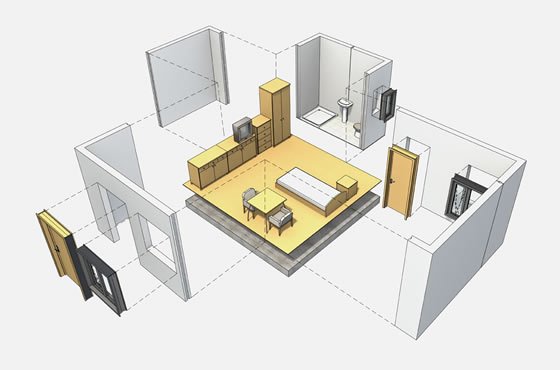The Elcon Building System
Since 1948, many hundreds of thousands of buildings have been erected world wide using precast concrete “Flat Panel” systems.
In the late 1960’s the Elcon System was developed utilising “L” shaped load bearing walls instead of flat panels, thereby dispensing with propping during erection and vastly reducing panel joints. The benefits of this high technology system have been appreciated the world over with the successful, trouble-free completion of thousands of dwellings, apartments, hotels, campuses and military cantonments. The immense strength and ruggedness of the system means that buildings can be constructed well in excess of thirty storeys high and in the most hostile geological environments. The Elcon system meets with the Zone 3 requirements of the Californian code for seismic design and the Florida Hurricane Code.
The flexibility of the Elcon System
Because house designs based on the Elcon System can be considerably varied, large housing schemes or estates need not look dull or uniform. The Elcon system permits varied internal planning and because the panels are cast in machined steel moulds, the accuracy and superb finish of the panels also means that finishes can be apllied direct. Equally the panels can be clad or treated externally to provide a variety of aesthetic solutions.
Economy of the Elcon System
The world wide usage of the Elcon system demonstrates it’s economic benefits in terms of speed and simplicity over comparable traditional buildings. The Elcon system does not require a highly skilled workforce for its manufacture or erection. The panels are completely self supporting and therefore site installation is simply achieved with a small number of operatives and a mobile crane keeping the erection procedure simple, speedy and economical.
The Elcon system was principally developed to deal with mass housing needs in developing countries. The system is sufficiently flexible to be used for other types of construction including hospitals, clinics, schools, municipal buildings and shops and is one of the few systems in the world capable of producing consistently up to 440m2 of erected building in each 24 hour period with a quality control which renders internal finishing trades a thing of the past.
Since its inception in 1969, the system has been used in 12 countries having various geological and climatic conditions ranging from the eathquake zones of Mexico (where it was granted Zone 3 status within the Californian code of seismic design) to the deserts of Saudi Arabia and the tropical rainforests of West Africa.
The Elcon system has always achieved considerable economic savings wherever it has been used. These savings have been achieved by efficiency and the fact that a much lower number of skilled and semi-skilled personnel are required compared with traditional construction methods.
The system has also been used in Russia where a specially designed sandwich panel gives adequate insulation from +40F to -30F.

